-Trending Prospects (12/9) - Doug McDermott, Scott Machado, Henry Sims
-Trending Prospects (12/22) - Kris Joseph, Draymond Green, Chace Stanback
-Trending Prospects (12/23) - Will Barton, LeBryan Nash and Ricardo Ratliffe
-Trending Prospects (12/30) - Mike Moser, Kenny Boynton and Jarrod Jones
-Trending Prospects (1/6) - Herb Pope, Eric Griffin, Otto Porter, Quincy Acy
-Trending Prospects (1/12) - Arnett Moultrie, Kevin Jones, Robbie Hummel, Elias Harris
-Trending Prospects (1/20) - Andrew Nicholson, William Buford, Orlando Johnson, Tyshawn Taylor
-Trending Prospects (1/26) - Jordan Taylor, J'Covan Brown, Ashton Gibbs, Jorge Gutierrez
-Trending Prospects (2/3) - Tu Holloway, Maalik Wayns, Rodney Williams, John Shurna
-Trending Prospects (2/10) - Terrence Ross, B.J. Young, Darius Miller and Isaiah Canaan
-Trending Prospects (2/19) - John Jenkins, Hollis Thompson, Kim English, Elijah Johnson
Doron Lamb, 6'5, Shooting Guard, Sophomore, Kentucky
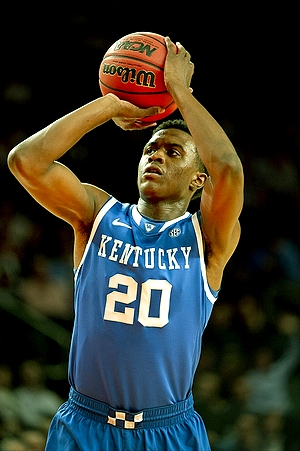
Kyle Nelson
While Doron Lamb was already a major contributor as a freshman, he has developed into a key player on both ends of the floor for arguably the best team in college basketball as a sophomore. While much of his game remains similar to when we last wrote about him, he has improved his draft stock by expanding his scoring and facilitating repertoire and embracing a slightly larger role for the incredibly deep and versatile 28-1 (14-0 in SEC) Kentucky Wildcats.
Measured at 6'5 with a 205-pound frame and a 6'7 wingspan, Lamb has a good physical profile for an NBA shooting guard with the potential to continue filling out his solid frame. While he lacks elite explosiveness, Lamb is nonetheless a solid athlete, possessing a solid first step and decent quickness in the open court.
Lamb remains a phenomenal perimeter shooter, making 49% of his 5.3 three point field goal attempts per 40 minutes pace adjusted, which technically ranks him as the best shooter in all of college basketball, at least amongst players considered draft prospects. His form is flawless and he is excellent shooting from a standstill and off of the dribble.
What has changed this year is that Lamb is seeing more minutes in a role as a facilitator, in large part due to the growing pains of freshman Marquis Teague, who has been very erratic at times. Lamb looks fairly comfortable operating as a primary shot creator in Kentucky's half-court offense, embracing his expanded role by scoring out of the pick and roll and shooting pull up mid-range jump shots.
Off the dribble, Lamb is mostly a straight-line slasher, often resorting to a floater once inside the paint. Not possessing elite size, strength, explosiveness or shot-creating prowess, Lamb relies mostly on his smarts and instincts to get himself good looks around the basket. Though he is getting to the foul line more often this year and has been more aggressively seeking contact than in the past, he still struggles to get clean looks around the basket and is shooting a less than impressive 46% from inside of the arc as a result.
Lamb is still not a pure point guard, looking more comfortable seeking out his own shot and lacking elite court vision, but he's doing a very good job running John Calipari's when called upon, moving the ball quickly, simply and unselfishly around the floor. His decision-making looks improved this season and he is turning the ball over on just 10% of his possessions, one of the best ratios among prospects in our database. He looks more capable facilitating the offense in half-court sets and, as mentioned before, shows a greater comfort operating out of the pick and roll, primarily though not exclusively as a scorer.
While Lamb lacks elite physical tools, he has once again proven to be a dependable and active defender at the collegiate level. He struggles to stay in front of quicker players at times, but he shows very good fundamentals and effort, suggesting that he will be a very capable defender at the next level with continued work on his strength and added experience.
Doron Lamb once again has managed to shine despite a Kentucky rotation filled with elite talent and he has done so while being more efficient in an expanded role. While his struggles getting and finishing inside the paint suggest he may be better suited in a complementary role, his combination of elite perimeter shooting, improved shot creating abilities, and developing instincts as a facilitator in the half-court are intriguing when projecting him at the next level. So, too are his defensive abilities, which should allow him to see minutes relatively quickly whenever he chooses to play in the NBA.
Lamb has proved himself as an extremely effective shooting guard prospect at the collegiate level, and appears to have everything needed to emerge as a strong role player in the NBA.
C.J. Leslie, 6'9, Sophomore, Power Forward, North Carolina State
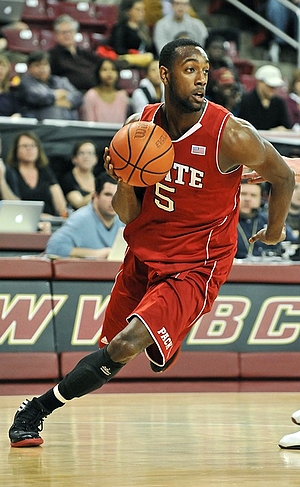
Matt Williams
Last time we checked in on C.J. Leslie, he was in the middle of an up-and-down freshman campaign under Sidney Lowe that ended with North Carolina State finishing below below-.500 for the third time in 15 years. Opting to stay in school despite Lowe's resignation, Leslie has had a much more efficient season for the Wolfpack for first-year Head Coach Mark Gottfried.
One of the most gifted athletes at the power forward position in the college game, the questions surrounding Leslie's NBA potential remain largely unchanged, despite the fact that he's been significantly more productive in a number of areas as a sophomore.
As we noted in our last report, Leslie's biggest strength as a prospect is his impressive blend of length, quickness, and explosiveness. He gets up the floor as well as any player his size in the country and while he lacks significant strength, he has the quick second jump to be an effective rebounder on both ends of the floor and when dialed in can make a major impact defensively.
Despite his merits as an athlete, his ability to consistently make the most of those assets is inconsistent at best at this juncture and is the most significant limiting factor on his impact in the college game and upside as a pro.
The young forward may still struggle at times with his approach to the game, but he has shown improvement in some areas. Getting most of his looks in simple catch-and-finish situations last season, or in transition, where he truly excels, Leslie has become a more prominent fixture in North Carolina State's offense, seeing significantly more opportunities to create his shot in one-on-one situations than he did as a freshman, both on the perimeter and in the low post.
Lacking significant polish on the block, Leslie relies on his ability to face-up and beat his defender to the basket in close quarters. He has little trouble finding his way to the rim or getting his shot off when he uses a simple drop-step, but doesn't always have the fundamentals, footwork, counter-moves, and aptitude for using fakes to regularly capitalize on the looks he does create for himself.
Often making a move and elevating off-balance as soon as he sees daylight, Leslie still manages to score 43.9% of his shot attempts in the post according to Synergy Sports Technology, a near 11% improvement from last season and a testament to just how valuable his athleticism is at the high-major level.
Leslie's propensity to take tough shots around the basket limits his efficiency to some degree, but his athleticism makes him a more than capable finisher around the rim, especially when he's getting the ball with a running start in transition or pulling down an offensive rebound for a put-back. On the whole, Leslie is most efficient when his teammates are creating shots for him, even if he has shown some budding skills in the post.
Away from the rim, Leslie is still in the early stages of his development out on the perimeter. His ball-handling ability remains unpolished, even if he uses straight line drives effectively when he faces up down low, thanks to his tremendous first step. Mostly guarded by power forwards at the NCAA level, Leslie doesn't need to make too many fancy moves to simply blow by his defender from the high post in isolation situations, which is a significant part of N.C. State's half-court attack.
To make the full conversion to playing on the perimeter, and to be able to begin his moves outside the 3-point line rather than at the elbow, Leslie will need to continue to shore up his ball-handling skills and decision making ability, which could have a huge impact on his effectiveness in the half-court.
As a jump shooter, Leslie hasn't made much progress, but he's been significantly more discerning with his shot selection. While he's still making less than 30% of his jumpers, he's not forcing the issue as frequently as he did last season and has shown marked improvement at the foul line, even if he is still only shooting 62% from the charity stripe. Only having made three 3-pointers on the season through 29 games, Leslie obviously still has a ways to go before he can be asked to play out on the perimeter full time.
Playing more like a power forward that he did last season, Leslie has found a way to be more productive and efficient despite his lack of polish, something he did not manage to do last season. If he's going to be successful at the next level, he'd be well served to show a more consistent motor running the floor, be more aggressive crashing the glass, or look to refine his face up game significantly, as questions remain about where he fits offensively.
Possessing all the physical tools necessary to be successful on that end of the floor, Leslie would benefit from playing a role that would allow him to capitalize on his athleticism in transition while affording him a chance to develop a comfort level as a face-up scorer from the midrange.
Defensively, Leslie is limited to some degree by his lack of bulk, but is mostly inhibited by his inconsistent motor. By no means is he an incapable defender, as he's been terrific for stretches, using his length to block shots at the rim and his quickness to deny dribble penetration, but he has not consistently competed with an intensity that let him get the most out of his abilities.
Taking possessions off, not always looking to rebound his area, and not contesting his match-up's short-range shots at all on occasion, the sophomore does not make the most of his tremendous length and quickness off the floor. If the light bulb does come on, his upside on this end of the floor is significant, but that still hasn't happened up until this point in his career.
Moving forward, it will be Leslie's work ethic and approach to the game that dictates how the early part of his career unfolds. With North Carolina State firmly on the bubble after four straight losses, Leslie's ability to get his team into the tournament and his play in March will be significant, as he's had some strong outings for the Wolfpack in recent weeks even if his team has not been winning games.
A potential early entrant, Leslie's draft stock is bound to his upside, and in the right situation with the right group of teammates and coaches at the next level, he could really make a team happy considering where he's likely to be picked. At just 20 years old, Leslie clearly has some maturation and a long career ahead of him, and considering his strengths and weaknesses, is an intriguing a boom or bust prospect to consider in the 20-40 range.
Darius Johnson-Odom, 6'3, Senior, SG, Marquette
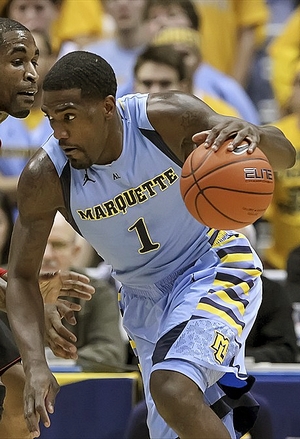
Derek Bodner
A 6'3 shooting guard with a 6'6 wingspan and broad shoulders, Darius Johnson-Odom has had a productive senior season, ranking second in the Big East in scoring while leading Marquette to an impressive 24-5 record.
The deadeye perimeter shooting ability he showed as a sophomore has mostly returned after a relatively disappointing junior season. While Johnson-Odom hasn't quite replicated the virtually unsustainable levels of efficiency he had as a sophomore (47.4% from three point range and 1.627 points per possession on catch and shoot jumpers), his 40.4% three point percentage should reassure most talent evaluators that his sophomore season wasn't a fluke.
On the negative side, Johnson-Odom still has yet to show much in the way of point guard instincts or the ability to create for others, a concern for a player who measured just 6'3 at the Kevin Durant Skills Academy last summer. Beyond not showing point guard instincts, he also tends to put his head down when driving to the rim, limiting his ability to capitalize on the attention defenses give him.
Johnson-Odom has always been a good catch and shoot player, a skill that will be very valuable at the next level when he is asked to create less. While he doesn't get all that much elevation on his jump shot, his good balance and follow through creates a very repeatable motion which allows him consistent results.
He's also shown an increased ability to make jump shots off of screens, something that can be utilized as he moves to more of an off the ball role at the next level.
Where Johnson-Odom has made the most progress is as a shooter is off the dribble. His 0.93 points per shot off the dribble represents a solid improvement off the 0.688 number he posted last year, and he looks significantly more comfortable with pull up and step back jumpers, which he didn't consistently show earlier in his career.
While he's unlikely to create off the dribble at the next level quite as much as he currently is asked to, having that skill set in his arsenal represents an advantage over many of his contemporaries.
Off the dribble, Johnson-Odom has some definite positive attributes, although this is held back somewhat by his limitations finishing at the rim. Johnson-Odom has a good combination of quickness, ball-handling skills with either hand and an ability to change speeds and direction, along with an improved ability to use his physical strength to gain separation and good touch with both hands.
That being said, his combination of size and average touch makes him an overall inefficient finisher at the rim.
On the defensive side of the ball, Johnson-Odom gives good effort on this side of the ball and has the upper and lower body strength to defend strong NBA shooting guards. His average size, however, is an issue for someone who is at his best off the ball.
If Johnson-Odom were 6'5 there would be no questions about his ability to contribute at the next level. His ability to make shots from the perimeter and create off the dribble are coveted skills, especially considering his winning pedigree and the intensity he brings on the defensive end.
Johnson-Odom's size may give some teams room for pause, but fortunately for him there is a long list of undersized shooting guards currently seeing extensive playing time in the NBA today. As much as any prospect, the personnel around Darius Johnson-Odom could play a hand in whether a team is able to find a role he could be effective in at the next level.
Bernard James, 6'10, PF/C, Senior, Florida State
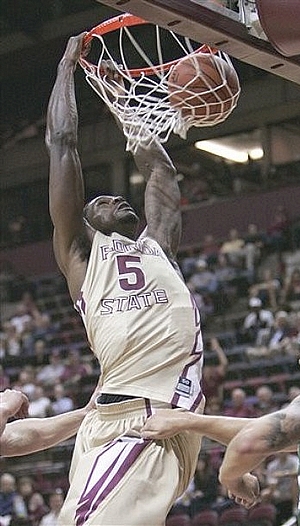
Joe Treutlein
Coming off a solid junior season where he established himself as an interesting NBA prospect despite his very advanced age, Bernard James is having a similar season as a senior. James has seen a slightly expanded role due to the departure of Florida State's two leading scorers from last year, but his pace adjusted production and efficiency numbers are all the same or slightly down, as he hasn't grown much from a skills perspective.
Looking at James' game, his strengths and weaknesses remain largely the same, and he's being utilized in a similar fashion to last season. His defense and rebounding remain his most attractive assets from an NBA perspective, unsurprising due to his central role on the country's 5th best defense according to kenpom.com.
In the post, James does an excellent job utilizing his high motor and physical tools to disrupt the opposition, playing a rangy, aggressive style that fits well into his team's scheme. He's a tremendously instinctive shot-blocker, doing an excellent job rotating from the weak-side and being a major factor for opposing slashers to deal with inside the paint.
This is likely his most appealing attribute as a NBA prospect, as it's not difficult to envision this part of his game translating to playing against better competition.
James is prone to overplaying the ball on fronts, but it's done within a team concept and the rewards far outweigh the risks. His best chance to make an impact in the pros initially would be with a creative, defensive-oriented coach who could take advantage of his tools, and it will be interesting to see if James can find ways to be similarly effective if he plays in a more vanilla scheme.
In terms of his straight man-to-man defense, James is still a bit rough around the edges, being prone to being beat laterally both in the post and on the perimeter. He doesn't move laterally especially well, likely due to fundamentals (he rarely bends his knees) more than athleticism, and it's something that also shows up in the pick-and-roll game, where he doesn't always play with nearly the same aggressiveness as in the other areas of his defense.
This could be by design, but is something that would be much more important for him in the highly pick-and-roll oriented NBA, and teams will probably want to study this more in pre-draft workouts.
On the offensive end, James hasn't shown much new with his slightly expanded role, as he's seeing a similar possession distribution to last season while his FG% is down slightly from 65.7% to 60.7%. His post game remains extremely raw, and he is absolutely reliant on his dominant left hand, while he's still lacking in touch and balance on his finesse moves more than a few feet from the basket.
He shows good ability to finish with power, but struggles when he doesn't have great position or is tightly defended, where he just doesn't have the coordination or polish to consistently finish on hook shots and contested lay-ups.
James does a good job finishing on off-ball plays such as cuts, pick-and-rolls, and offensive rebounds, but this aspect of his game isn't emphasized highly in Florida State's offense, which isn't the prettiest or most effective you'd find in the NCAA.
This area of his game could certainly benefit from playing with a better cast of offensive talent and more open system, especially when he wouldn't be relied on to have the second most field goal attempts on his team, a tough burden for a player with his very limited skill set.
Because his post game likely won't translate very effectively to the NBA and there's only so much he can do to improve as an off-ball finisher, the most significant improvement James could make on the offensive end would be developing a respectable 15-foot jump shot, something he's shown no sign of in his two seasons in college.
His shooting mechanics, on the rare chance he takes a shot once in a blue moon, are not pretty to say the least, and he's shooting a very poor 52% from the free-throw line this season (up slightly from 50% last year).
Even with his limited basketball experience, he's fighting an uphill battle on this front, as it's tough to see him developing a respectable NBA jump shot from nothing given that he's already 27 years old.
Looking forward, James' size, athletic tools, defensive abilities, and intangibles give him a nice package that will make him attractive to many NBA teams. His value as a practice player and teammate could certainly help endear him to some coaches, especially ones who have creative defensive schemes they believe they could effectively utilize him in.
His advanced age will be a significant issue for many teams, but some playoff teams could actually view it as an asset, especially in combination with his off-court experience in the military. Given the historically awful success rate of late second round picks in the draft, James could be seen as an attractive choice to the right team, for the intangibles he brings to the table and the chance he could still continue developing despite his age.













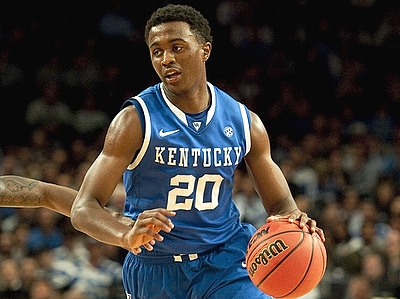




















Comments